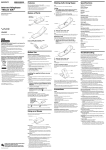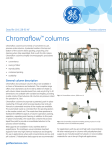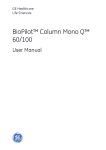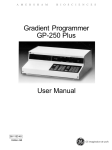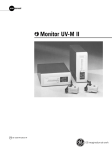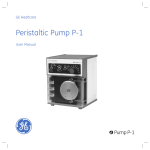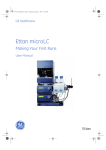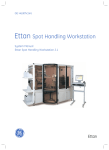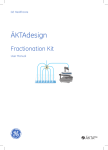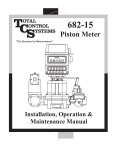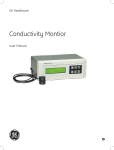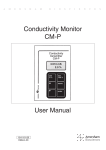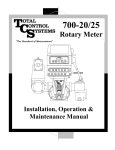Download マニュアル High Precision Pump P-500
Transcript
GE Healthcare High Precision Pump P-500 User Manual Important user information All users must read this entire manual to fully understand the safe use of High Precision Pump P-500. WARNING! The WARNING! sign highlights instructions that must be followed to avoid personal injury. It is important not to proceed until all stated conditions are met and clearly understood. CAUTION! The Caution! sign highlights instructions that must be followed to avoid damage to the product or other equipment. It is important not to proceed until all stated conditions are met and clearly understood. Note The Note sign is used to indicate information important for trouble-free and optimal use of the product. CE Certifying This product meets the requirements of applicable CE-directives. A copy of the corresponding Declaration of Conformity is available on request. The CE symbol and corresponding declaration of conformity, is valid for the instrument when it is: – used as a stand-alone unit, or – connected to other CE-marked GE Healthcare instruments, or – connected to other products recommended or described in this manual, and – used in the same state as it was delivered from GE Healthcare except for alterations described in this manual. WARNING! This is a Class A product. In a domestic environment this product may cause radio interference in which case the user may be required to take adequate measures. Recycling This symbol indicates that the waste of electrical and electronic equipment must not be disposed as unsorted municipal waste and must be collected separately. Please contact an authorized representative of the manufacturer for information concerning the decommissioning of equipment. Contents Contents 1 Introduction 2 Specifications 3 Unpacking and equipment list 4 Description 4.1 Front panel........................................................................................................................13 4.2. Rear panel .........................................................................................................................16 5 Installation 5.1 5.2 5.3 6 Operation 6.1 6.2 6.3 6.4 6.5 6.6 7 Mains installation...........................................................................................................19 Tubing connections ......................................................................................................21 Start-up procedure .......................................................................................................21 Routine operation ..........................................................................................................23 Solvents ..............................................................................................................................23 Pressure limit control ...................................................................................................24 Pulse compensation .....................................................................................................25 Pump head cleaning ....................................................................................................26 Connections to the remote control socket ........................................................26 Maintenance and servicing 7.1 7.2 Piston seal replacement .............................................................................................29 Recycling ...........................................................................................................................32 8 Trouble shooting 9 Spare parts and accessories High Precision Pump P-500 User Manual 56-1129-73 Edition AI 5 Contents 6 High Precision Pump P-500 User Manual 56-1129-73 Edition AI Introduction 1 1 Introduction The High Precision Pump P-500 (Code No. 18-1003-65) is a laboratory pump for use in liquid chromatography and other applications where constant flow at pressures up to 4 MPa (40 bar, 580 psi) is required. Pump P-500 is very accurate and reproducible, especially at low flow rates over the whole pressure range. The excellent chemical resistance of the pump makes it possible to work with corrosive liquids, e.g. organic solvents, as well as aqueous solutions. Pump P-500 is designed to facilitate routine chromatography work. The flow rate is easily and accurately set with a three digit thumb-wheel switch. The wide flow range makes the pump suitable both for analytical and preparative chromatography. A unique wash program provides fast and secure solvent change-over and a pressure limit control protects the column from damaging pressures. Together with the Gradient Programmer GP-250 Plus or the Liquid Chromatography Controller LCC-501 Plus, the Pump P-500 can be used to form accurate and reproducible gradients. Pump P-500 is fully compatible with other equipment such as the single and dual path UV-monitoring systems UV-M II, UV-1, and their associated recorders and with the TM Fraction Collectors FRAC-100, FRAC-200 and SuperFrac . Pump P-500 is designed to work with a wide range of columns and gels supplied by GE Healthcare. WARNING! When using hazardous chemicals, take all suitable protective measures, such as wearing protective glasses and gloves resistant to the chemicals used. Follow local regulations and instructions for safe operation and maintenance of the system. High Precision Pump P-500 User Manual 56-1129-73 Edition AI 7 1 Introduction 8 High Precision Pump P-500 User Manual 56-1129-73 Edition AI Specifications 2 2 Specifications Flow rate range 1–499 ml/h variable in steps of 1 ml/h. Operating pressure 4.0 MPa (40 bar, 580 psi) up to 200 ml/h. 2.5 MPa (25 bar, 360 psi) in the range 200–499 ml/h. Flow rate accuracy ± 1.5% of setting or ± 0.5 ml/h (which ever Reproducibility Better than 0.5% set flow rate. Flow rate precision Better than 1% over 8 hours at 160 ml/h with the same solvent and temperature. Materials of wetted parts Fluoroplastics (Kel-F, Tefzel , Teflon ), PEEK, PFE (Simriz ), titanium and borosilicate glass. Pressure read out 0–5.0 MPa (0-50 bar, 0–700 psi). Pressure recording 0.5 MPa (5 bar, 70 psi)/mV. Pressure limit Protective shutdown, adjustable in the range 0–5.0 MPa (0–50 bar, 0–700 psi). Power supply, voltage frequency 100/120/220-230/240 V~ 50–60 Hz Power consumption 32 VA Environment +4 to 40 ° C, 20–95% relative humidity, 84–106 kPa (840–060 mbar) atmospheric pressure. Dimensions 410 x 217 x 165 mm. Weight 9 kg. Motor Stepper motor (110 pulses/0.1 ml). Compliance with standards The declaration of conformity is valid for the instrument only if it is: Safety standards High Precision Pump P-500 User Manual 56-1129-73 Edition AI TM TM TM • used in labaratory locations • used in the same stat as it was delivered from GE Healthcare except for alterations described in the User Manual. • connected to other CE labelled GE Healthcare modules or other products as recommended. This product meets the requirement of the Low Voltage Directive (LVD) 73/23/EEC through the following harmonized standards: • EN 61010-1 • IEC 61010-1 • CAN/CSA-C22.2 No. 61010-1 • UL61010-1 9 2 Specifications EMC standards This device meets the requirements of the EMC Directive 89/336/ EEC through the following harmonized standards: • EN 61326 (emission and immunity) • EN 55011, GR 2, Class A (emission) • This device complies with part 15 of the FCC rules (emission). Operation is subject to the following two conditions: 1 This device may not cause harmful interference. 2 This device must accept any interference received, including interference that may cause undesired operation. 10 High Precision Pump P-500 User Manual 56-1129-73 Edition AI Unpacking and equipment list 3 3 Unpacking and equipment list Unpack Pump P-500 carefully and check the contents of the carton against the packing list. Save the packing material and the carton in case Pump P-500 needs to be returned. Check Pump P-500 for any visible signs of damage that may have occurred during transit. CAUTION! The system should be installed on a stable laboratory bench providing a suitable working area. Place Pump P-500 on the bench and check that it is set to the appropriate voltage (see Section “4.2. Rear panel”). Before operating the pump carefully read Section “5. Installation”. High Precision Pump P-500 User Manual 56-1129-73 Edition AI 11 3 Unpacking and equipment list 12 High Precision Pump P-500 User Manual 56-1129-73 Edition AI Description 4 4 Description 4.1 Front panel Controls and indicators Please refer to figure 1. Detail No. Description Function 1 SET, spring-loaded push button Pressing the button and simultaneously turning the SET potentiometer sets limit pressure. Momentarily pressing the button after pump shutdown caused by excessive pressure, restores operation. 2 SET, potentiometer Sets pressure limit when used in combination with SET pringloaded push button. 3 LIMIT, indicator lamp Lights up when the pump shuts down if preset high pressure limit is exceeded. 4 PRESSURE, MPa meter Indicates the actual operating pressure in the range 0–5.0 MPa (0–50 bar). The range 4.0–5.0 MPa is marked red and should not be exceeded. 5 Potentiometer (screw driver adjustable). Adjusts the pressure output to 0. 6 Change direction, push button Momentarily pressing the button changes the driving direction of the pistons. Holding the spring loaded button depressed gives maximum flow rate independent of the flow rate setting. 7 PULSE COMP, push button Pulse compensation reduces pulses to a minimum. Especially useful when monitoring at high sensitivities. 8 FLOW RATE ml/h, three digit thumb-wheel switch of Sets flow rate. Adjustable in steps 1 ml/h in the range 1–499 ml/h. 9 RUN, indicator lamp The lamp lights up when the pump is in the RUN position. 10 RUN, push button Run position In the Run position the pump is ready for operation, according to the setting of the different controls. Standby position In the Standby position the pump is shutdown but is supplied with current. Used when the pump is to be stopped temporarily. High Precision Pump P-500 User Manual 56-1129-73 Edition AI 13 4 Description Detail No. Description Function 11 SOLVENT CHANGE, push button Starts a wash program to change the previous solvent in the pump. This control works only if the pump is already in the RUN mode. 12 POWER, mains switch Supplies mains power to Pump P-500. 1 2 3 4 5 Pressure sensor 6-port valve Piston Fixing screw End Tubing Rinsing tubing for cylinder piece cover connections assembly Protective covers 6 7 8 Piston 9 10 11 End piece 12 Fixing screw for cylinder assembly Fig 1. Pump P-500 front panel. Fluid delivery Pumping action is provided by a stepper motor, through a gear box and a ball screw, to two alternating pistons mounted on the front panel (Fig 1). The driving mechanism is located behind the front panel. The pistons reciprocate in two high precision glass cylinders. The pistons are driven such that one piston draws in solvent while the other is expelling solvent. The change of piston direction is controlled by opto-electronic switches at the end positions. These switches also control valve movement. Fig 2. The piston. Each piston consists of three parts: a head, a sealing ring, and a connecting rod (Fig 2). The piston/cylinder mechanism offers durability, resistance to corrosive fluids and easy disassembly for servicing. 14 High Precision Pump P-500 User Manual 56-1129-73 Edition AI Description 4 Valve The six-port valve (Fig 1) is a motorized rotary valve driven by a DC-motor through a gear box. The function of the valve is to control the solvent flow to and from the pistons. The valve has six tubing connections. These tubing connections and the general flow diagram are shown in figure 3. All connections except the two labelled IN and OUT are already fitted. L1 OUT L2 IN R1 1 2 R2 1 2 Fig 3. General flow diagram. The valve operates automatically when the pistons reach their end positions. This is sensed by opto-electronic switches. The valve also operates when the button (change direction) is pressed. Pressure sensor The pressure sensor (Fig 1) is a strain gauge bridge type which determines the back pressure in the system. The pressure sensor consists of a diaphragm which contracts or expands with pressure changes causing the resistance in an electronic bridge to change. This gives a signal proportional to the back pressure. The signal is then amplified and relayed to the pressure meter (front panel) and the pressure output (rear panel). The pressure sensor has two main functions, the first to continuously measure the operating pressure and the second to sense excessive pressure which could damage the columns. If the pressure builds up to the limit set on the SET control, the pump automatically shuts down and the red LIMIT lamp lights. Detailed instructions for setting the pressure limit and for the connection of a recorder to the pressure output are given in Section “6.3. Pressure limit control”. Security cover Pump P-500 is equipped with a security cover to protect the user from breakage of the glass cylinders resulting from incorrect handling. The security cover is easily mounted and dismounted by just snapping it on and off from its pressure points. High Precision Pump P-500 User Manual 56-1129-73 Edition AI 15 4 Description Tubing connectors All tubings in the pump are supplied with a new type of tubing connector. Each tubing connector consists of two parts, a nipple and a nipple screw. The tubings supplied with the pump are preflanged but tubings of any length can also be flanged with the Flanging/Start up Kit, Code No. 19-5079-01, 120 V, or 19-5090-01, 220 V, supplied on request. The tubing connectors are also compatible with the GE Healthcare solvent resistant (SR) chromatography system. 4.2. Rear panel See figure 4. Voltage selector Adapts Pump P-500 to 100, 120, 220–230 or 240 V. Mains Socket for mains inlet. Fuse This holds a 160 mA fuse for 220–230 V instruments or a 300 mA for 110 and 120 V instruments. The fuse protects the electronics from damage in the event of short circuiting. Pressure output This is connected to a recorder, such as recorder REC 111 or REC 112. The recorder can be used to plot the operating pressure (in the range 0–4.0 MPa) during any given experimental run. The output signal from the pressure sensor is 1 mV/0.5 MPa (5 bar). Remote control This is a 15 pin female connector of the D-type. The numbers referred to are printed on the connector. Note: All outputs must have an external pull-up resistor (2–10 KΩ ) to + 5V. 16 High Precision Pump P-500 User Manual 56-1129-73 Edition AI Description 4 4 3 1 2 Fig 4. The rear panel. 1. Voltage selector 2. Mains socket 3. Pressure output 4. Remote socket Outputs TTL open collector, 5V Direction of piston’s movement (pin 4) 1=left 0=right Pump occupied (pin 9) 1=OK 0=occupied The pump is “occupied” during the following activities: wash program, valve change, too low mains voltage, standby position or pressure limit shutdown. Shutdown due to error (pin 10) 1=error 0=OK There are two possibilities for error indication, no mains voltage or pressure limit shutdown. External control is not possible during error indication. Actual speed (pin 13) 0–153 Hz Ground (pin 15) Inputs (TTL activation) External activation of wash program (pin 1) 1=not activated 0=activated External direction control (pin 2) 1 =not activated 0=valve switch External RUN/STANDBY control (pin 11) 1=run 0=STANDBY Internal/external speed control (pin 12) 1=internal 0=external When external speed control is used (pin 14) 0-153 Hz, (pin 12) must be 0 (see above). Pins 3, 5,6,7 and 8 are not connected. High Precision Pump P-500 User Manual 56-1129-73 Edition AI 17 4 Description 18 High Precision Pump P-500 User Manual 56-1129-73 Edition AI Installation 5 5 Installation 5.1 Mains installation Before conecting Pump P-500 to the mains supply, please read the following instructions carefully. 1. There are two Mains Kits supplied (one for 100–120 V and one for 220/240). Choose the kit appropriate to the local mains supply voltage and discard the irrelevant kit immediately. WARNING! Only use mains cables delivered or approved by GE Healthcare. WARNING! Installing the wrong mains kit can endanger personal safety and cause irreparable damage to the pump. Always connect the instrument to a properly grounded mains outlet. 2. 3. Remove the warning label covering the fuse/voltage selector unit on the rear panel. Open the fuse/voltage selector cover with a thin screwdriver or the key provided (Figs 5 and 6). Fig 5. Opening the fuse/voltage selector cover. When using the screwdriver to open the cover, insert it at the top centre and apply pressure. 4. Place the fuse into the fuseholder and install it into the instrument in the right-hand position (Fig. 7). 5. Remove the voltage selector switch, select correct voltage and place the switch into the instrument with the correct voltage showing (Fig 8). Note: Use 220 V setting for 230 V mains outlet. 6. Close the cover. The correct voltage should be visible in the window. 7. Connect Pump P-500 to a grounded mains outlet using the cable supplied in the Mains Kit. WARNING! In case of an emergency situation, the mains plug must always be easy to disconnect. High Precision Pump P-500 User Manual 56-1129-73 Edition AI 19 5 Installation Fig 6. Opening the fuse voltage selector cover using lateral pressure with the key provided. Fig 7. Installing the fuseholder. Always use the hole at the righthand side when you install the fuseholder. Fig 8. Choose the correct voltage by turning the voltage selector. 20 High Precision Pump P-500 User Manual 56-1129-73 Edition AI Installation 5 5.2 Tubing connections Inlet and outlet tubings The inlet and outlet tubings are supplied preflanged. The outlet tubing with a dimension of 1.8 x 0.5 mm has tubing connectors attached at both ends. The inlet tubing has a tubing connector attached at one end and a solvent filter at the other end. The solvent filter consists of a filter holder made of fluoroplastic and a filter insert containing a guide ring and a filter with a pore size of 2 micron. The filter is made of polypropylene. Also supplied are 5 extra filter inserts which are for replacement when the filter becomes blocked. The filter insert is replaced by snapping off the guide ring and filter with a spatula or similar tool and inserting a new one. Extra filter inserts are available on request, Code No. 19-5086-01. Rinsing tubings The rinsing tubing has a dimension of 3.1 x 1.1 mm. Cut two pieces of the rinsing tube supplied to a sufficient length to reach the bottom of a rinsing solution bottle and connect them to the rinsing tubing connections (Fig 1). Internal tubings The internal tubings in the pump shown in figure 3 have a dimension of 1.8 x 0.8 mm. Worn out tubing should be replaced with the same size of tubing. A tubing kit is available on request. Code No. 19-4434-01. 5.3 Start-up procedure P-500 is factory tested prior to delivery. To ensure that it is functioning properly upon start-up, the following procedure should be performed step by step. 1. Check that the power switch (Fig 1) is set to “OFF” and plug the mains cable into the mains inlet. 2. Connect the inlet tubing to the connection on the right hand side of the valve marked and the outlet tubing to the upper connection on the pressure sensor (see Fig 9). Tighten the tubing connectors by using the wrench supplied. Use the end marked N. → outlet inlet Fig 9. Connection of the outlet and inlet tubing. 3. Submerge the inlet tubing in a suitable reservoir filled with degassed distilled water. 4. Submerge the rinsing tubing in a suitable reservoir filled with rinsing solution i.e. 20% ethanol. High Precision Pump P-500 User Manual 56-1129-73 Edition AI 21 5 Installation 5. Check that the button RUN (Fig 1) is released, the pump is in standby position and turn power switch to ON. 6. Set the pressure limit to 4.5 MPa (45 bar) by fully pressing the button SET (Fig 1) and simultaneously turning the potentiometer SET (Fig 1) clockwise. Read the value from the pressure meter. 7. Start the wash program by pressing the button SOLVENT CHANGE (Fig 1) and the button RUN. Note: When the pump is run for the first time friction between the dry glass cylinder and the dry sealing ring may give rise to some noise. It will however dissapear when the parts have been wetted. 8. When the pump stops after completion of the wash program (approximately 5 minutes), release the SOLVENT CHANGE button. 9. The cylinder is now filled with rinsing solution behind the pump heads. Connect the rinsing tube connections on the back of the pump heads with a short piece of rinsing tubing. The wash liquid will now be flushed between the two cylinders when the pump operates. 10. Run the pump until the piston heads are at the middle of their cylinders. 11. Block the solvent outlet using the stop plug supplied. 12. Set flow rate to 10 ml/h with the three digit thumbwheel switch and start fluid delivery by releasing the button SOLVENT CHANGE. Run the pump until the back pressure is 4.0 MPa (40 bar), indicated on the pressure meter, and check against the following list for possible leaks. Leakage Action Tubing connections Tighten the leaking tubing connector with the wrench supplied. Between end piece and glass cylinder Tighten the two M3 nuts or change the gasket according to Section “7.1 Piston seal replacement” Leakage between piston O-ring and glass cylinder. Replace the piston O-ring according to section 7.1 13. Press the button (change direction), the outlet is now onnected to the other piston. Start fluid delivery and run until the back pressure is 4.0 MPa. Check for possible leaks. 14. The pump is now ready for operation. Before changing solvent see Section “6.2. Solvents”. 22 High Precision Pump P-500 User Manual 56-1129-73 Edition AI Operation 6 6 Operation 6.1 Routine operation This section is a guide for routine operation and assumes that Pump P-500 has been installed according to the Section “5. Installation”. WARNING! When using hazardous chemicals, take all suitable protective measures, such as wearing protective glasses and gloves resistant to the chemicals used. Follow local regulations and instructions for safe operation and maintenance of the system. 1. Fill the solvent reservoir with sufficient solvent. Check that all solvent considerations are met, check solvent miscibility if change of solvent in the pump is desired (see Section “6.2. Solvents). 2. Check that the button RUN is released, pump is in standby position and turn the POWER switch to ON. 3. Set the desired flow rate with the three digit thumbwheel switch. 4. If change of solvent in the pump is desired, press SOLVENT CHANGE and start the wash program by pressing RUN. 5. Set the desired pressure limit by simultaneously pressing the button SET and turning the potentiometer SET. The pressure limit can be changed during a run. 6. Connect the outlet tubing to the injection valve. 7. When monitoring at high sensitivities with a system giving a back pressure greater than 0.5 MPa (5 bar), press PULSE COMP to activate the pulse compensation circuit. 8. Start fluid delivery by pressing RUN, or if solvent change over has been performed as in step 4, release the button SOLVENT CHANGE. 6.2 Solvents Degassing and filtering The use of filtered, degassed solvents and buffers is important for maintenance-free operation. Particles in the solvent can block the channels in the valve, shortening its life-time. Degassing prevents the formation of air bubbles which can cause baseline noise and drift. Degassing and filtering of solvents, except for solvents with low boiling points, can be performed in a one-step procedure by filtering the solvent through a vacuum filter (0.45 micron filter is recommended). Solvents with low boiling points, e.g. methylene chloride, can be degassed in a sonic bath. The boiling point of the solvent should be checked prior to degassing. Mixing solvents Prior to changing from one solvent to another, the miscibility of the solvents must be determined. Change of solvents which are immiscible requires an intermediate solvent, e.g. change from water to methanol can be made directly, while change from water to hexane requires an intermediate step such as 2-propanol. High Precision Pump P-500 User Manual 56-1129-73 Edition AI 23 6 Operation Solvent changeover Pump P-500 is equipped with an automatic wash program that facilitates solvent change over. Valve V–7 and Motor Valve MV–7 are 3-position valves with a wash position which enables solvent change without disconnecting the column from the pump. To change solvent in the pump proceed as follows: 1. Set the pump in standby position by releasing the RUN button. 2. Submerge the inlet tubing in the new solvent reservoir (minimum 40 ml). 3. If a V–7/MV–7 valve is included in the chromatographic system, set the valve to position WASH. Otherwise disconnect the outlet tubing from the injection valve. 4. Start the wash program by pressing the buttons SOLVENT CHANGE and RUN. The previous solvent is now automatically rinsed out and replaced with the new solvent. The duration of the program is approximately 5 minutes, depending on the position of the pistons when the program starts. 5. If there are any air bubbles trapped in the glass cylinders after completion of the wash program, a quick way to remove them is to release the button SOLVENT CHANGE and to press the button (change direction) when the piston reaches its end position. Press (change direction) several times until the air bubbles are removed. Solvent resistance Pump P-500 can be used with all types of buffers, detergents and organic solvents commonly used in chromatography. In addition, most inorganic and organic acids and bases e.g. diluted mineral acids, metal salt solutions, carboxy acids, anhydrides, aromatic and aliphatic hydrocarbons, alcohols, aldehydes, ketones, ethers, esters and chlorinated hydrocarbons can be used. The following solvents should not be used in the pump: concentrated nitric acid, oxidizing acids, organic bases, high concentrations of sulphonic acid, ethyl ether and fluoride solutions. Note: Do not leave acids, e.g. sulphuric acid, in the pump after use. Once the run is completed, the acid should be washed out. 6.3 Pressure limit control Pump P-500 is equipped with a protective pressure limit control which automatically shuts down the pump if the back pressure should build up to the limit set on the overpressure circuit. The pressure limit can be set either in the RUN or standby position. To set the pressure limit proceed as follows. Press the button SET. The actual pressure limit is shown in the pressure meter. To change the pressure limit, turn the potentiometer SET whilst simultaneously pressing the push button SET (see Fig 10). 24 High Precision Pump P-500 User Manual 56-1129-73 Edition AI Operation 6 Fig 10. Setting the pressure limit. To check the set pressure limit during operation or in standby position, press the push button SET and read the actual value from the pressure meter. If the pump shuts down due to the pressure limit having been exceeded (indicated when the red LIMIT lamp lights up), check if the column or tubings are blocked. After the condition has been corrected, restore pump operation by momentarily pressing the button SET. The pump does not start until the button is released. This gives an opportunity to check the actual pressure limit and to change it if necessary before the pump operation is restored. Connection to the pressure output When a plot of the operating pressure on a recorder is desired, connect the signal input cable (Code No. 18-1115-25) into the output PRESSURE on the rear panel of the pump (red to red and black to black) and to the recorder. Set the recorder range selector to 10 mV and adjust the recorder zero. The plotted pressure will be 5.0 MPa (50 bar, 700 psi) full scale response. Zero adjustment If the pressure output does not read O when the pump is in standby position or if the back pressure is O during run, the pressure sensor needs to be zero adjusted. The adjustment is performed by putting a screwdriver in the hole next to the pressure meter (see Fig 1) and turning the adjusting screw until the pressure meter reads zero. If exact zero adjustment of the pressure sensor is required, a recorder should be connected to the pressure output on the rear panel and the adjustment is performed until the recorder reads zero. 6.4 Pulse compensation When monitoring at high sensitivities with systems giving a back pressure, disturbance of the baseline can occur when the pistons change direction. This disturbance can be eliminated by using a pulse damper. Pump P-500 is designed with a pulse compensation circuit which operates when the button PULSE COMP is pressed. The principle for pulse compensation is as follows: Without pulse compensation, piston A reaches its end position and the operating pressure starts to decrease as the valve starts to switch. No flow is delivered from the pump during this time period. When the piston B is connected to the outlet the operating pressure is momentarily decreased. The operating pressure is then built up to the previous level before the valve started to switch. High Precision Pump P-500 User Manual 56-1129-73 Edition AI 25 6 Operation When the pulse compensation circuit is activated, the scheme is as follows: piston B starts working at the highest flow rate when piston A reaches its end position and the valve starts to switch. The back pressure for piston B is built up during the valve switching time. When piston B is connected to the outlet the operating pressure will be very close to the previous level before the pistons changed direction. The pressure drop is eliminated and no disturbance of the baseline will occur. Note: The pulse compensation should not be used when working with systems giving a back pressure less than 0.5 MPa (5 bar). 6.5 Pump head cleaning The pump head construction facilitates regular cleaning of the glass cylinder, both in front of and behind the piston head. Regular cleaning of the glass cylinders prolongs the life length of both the piston head O-rings and the glass cylinders, and also frees the pump head from bacterial contamination. The following section describes how to clean the pump head. It is adviseable to change rinsing solution routinely every day. We recommend 20% ethanol as rinsing solution. 1. Connect rinsing tubing to each cylinder and empty the old rinsing solution from behind the pump heads by running the pump for at least one stroke. 2. Submerge the rinsing tubing in a suitable reservoir filled with rinsing solution. 3. Fill the cylinders with new rinsing solution by running at least one stroke. 4. Reconnect the two cylinders with a piece of rinsing tubing. 6.6 Connections to the remote control socket Pump P-500 can give and receive information, i.e. flow rate, direction of piston movement, etc. For the complete list of information that can be given to, or received from other instruments see Remote control Section “4.2. Rear panel”. Volume information to a fraction collector The volume corresponding to a pulse given from the motor is 0.91 μl and this information can be used to determine fraction sizes in a fraction collector. There are separate procedures for calibration of volume information transmitted from the P-500 to Fraction Collectors SuperFrac, FRAC–100 and FRAC–200. Calibration of volume information to SuperFrac Connection to SuperFrac is made with a special signal cable (Communication Cable, Code No. 19-6005-02) Follow the step by step procedure below. Pump calibration Pump calibration can be performed in two different ways: 26 1. Manual calibration by using a constant. 2. Automatic calibration by using a measuring glass. High Precision Pump P-500 User Manual 56-1129-73 Edition AI Operation 6 1. Manual calibration by using constant In this case calibration is performed by entering an already known constant K. K is expressed in pulses per 0.1 ml and is limited to the range 1 ≤ K ≤3 276. The calibration constant K for Pump P-500 is 110 pulses/0.1 ml. Calibration must be performed when SuperFrac is in home position. See example below. Display Key Comments 8 8 8 8 calibrate 3 8 0 ENT Display shows actual constant Enter constant, e.g. K=380 xxxx 3 38 380 rdy Calibration ready Error messages/Check codes: Display Comments 8 K outside the limit Err 2. Automatic calibration by using measuring glass. Connect the Pump P-500 tubing to an eluent reservoir and fill the pump tubing with liquid. Connect Pump P-500 to SuperFrac and set the pump in run position. Perform the basic programming of SuperFrac. Select volume mode. Place a graduated cylinder under the outlet tubing and start calibration by pressing the keys: calibration flow rate and then hold. SuperFrac will count the pulses from the pump. Collect about 10 ml of liquid and stop the calibration. Enter the collected volume and press ENT. SuperFrac calculates the calibration constant K= P/V (pulses/0.1 ml), where P is the number of the counted pulses and V is the volume in ml. SuperFrac is now calibrated. See example below. Display Key Comments 8 8 8 8 8 8 8 calibrate hold stop 1 0 . 5 ENT Display shows actual constant Start calibration Stop calibration Enter volume, e.g. 10.5 ml xxxx CAL 0 1 10 10. 10.5 rdyr High Precision Pump P-500 User Manual 56-1129-73 Edition AI Calibration ready 27 6 Operation Error messages/Check codes: Display Comments 81 82 Volume gives K outside the limit P = 0 or “overflow” Err Err Calibration of volume information to FRAC-100 and FRAC-200 Pump P-500 is connected to FRAC-100/200 with a special cable Communication Cable, Code No. 19-6005-02). Connect the cable to the REMOTE socket of Pump P-500 and to socket marked REMOTE of FRAC-100 or FRAC-200. There is a special internal calibration circuit in FRAC-100 and FRAC-200 which enables any fraction size in the range 0.01–9,999 ml to be selected. Sometimes it will be convenient to program the calibration value directly without performing the calibration procedure; the calibration value for Pump P-500 is 110, which corresponds to the number of pulses/0.1 ml received from the pump at 20 °C with distilled water. For the best results, perform the complete calibration procedure, described in FRAC-100/ FRAC-200 Instruction Manual for the solvent/temperature combination in use. Connection to a controller In completely automated systems, Pump P-500 can be controlled from Gradient Programmer GP-250 Plus or Liquid Chromatography Controller LCC-501 Plus. The connection is made with the Communication Cable, Code No. 19-6005-02. Connected to a controller, all pump activities can be controlled and automated according to programmed instructions. Pump P-500 can then form gradients and perform operations following any of the chosen programs. 28 High Precision Pump P-500 User Manual 56-1129-73 Edition AI Maintenance and servicing 7 7 Maintenance and servicing 7.1 Piston seal replacement Wipe the instrument regularly with a damp cloth. Let the instrument dry completely before use. See also Section 6.5 for pump head cleaning. WARNING! Remove liquid or dirt from the system surface using a cloth and, if necessary, a mild cleaning agent. WARNING! When using hazardous chemicals, take all suitable protective measure, such as wearing protective glasses and gloves resistant to the chemicals used. Follow local regulations and instructions for safe operation and maintenance of the system. WARNING! When using hazardous chemicals, make sure that the entire system has been flushed thoroughly with bacteriostatic solutions, e.g. NaOH, and distilled water before service and maintenance. The following procedure describes how to replace worn piston seals using components from the sealing kit P-500, Code No. 18-1104-96. 1. Check that PULSE COMP is not activated (button released), otherwise adjustment is not possible. 2. Prepare a clean working space. 3. Remove the rinsing tubing. 4. Remove the security cover by grasping it at both sides and snapping it off from its pressure points. 5. Remove the protective cover of the piston rod by undoing the two Philips screws. 6. Remove the tubing cover (see Fig 1) by undoing the Philips screw. 7. Start the pump and run until the pistons reach the middle of their cylinders. Stop the pump by releasing the RUN button. 8. Disengage the piston rod from the driving arm by removing the stop screw with the Allen key supplied (see Fig 11). Fig 11. Disengaging the piston rod from the driving arm. 9. Unscrew, clock-wise, the locking screw for the pump cylinder (see Fig 12) and remove the pump cylinder. Disconnect the inlet and outlet tubings from the cylinder. High Precision Pump P-500 User Manual 56-1129-73 Edition AI 29 7 Maintenance and servicing Fig 12. Removing the locking screw for the pump cylinder. 10. Unscrew the M3 nuts from the support rods (see Fig 13). Carefully remove the glass cylinder together with the end piece and gently pull out the piston. Fig 13. Unscrewing the nuts from the support rods. 11. Remove the piston O-ring using a needle (see Fig 14). Be careful vnot to damage the piston head during this operation. Fit the new O-ring by hand. Fig 14. Removing the piston O-ring. 30 High Precision Pump P-500 User Manual 56-1129-73 Edition AI Maintenance and servicing 7 12. The wiper (see Fig 15 position 7), is replaced by pressing it out from the rod. Press a new wiper onto the rod. The hole on the wiper should point towards the pump head. 13. Moisten the piston head with distilled water and push the piston into the glass cylinder. 1 2 3 9 8 7 6 4 5 Fig 15. Pump head components. 1.Support rod assembly 2. Glass cylinder 3. Piston rod 4. Piston head O-ring 5. End-piece 6. End-piece gasket 7. Wiper 8. End-piece 9. Steel M3 nuts 14. Replace the white gasket ring (see Fig 15 position 6) between the end piece and the glass cylinder. Use a spatula to remove the worn out gasket ring. 15. Place the flat edge of the support rod assembly on a flat surface (see Fig 16). Fig 16. The cylinder package. Note that the tubing connectors are parallel to the flat surface on the end piece on the support rod assembly and that the rinsing tubing connector point upwards. 16. Mount the end piece on the support rod assembly so the tubing connectors are parallel to the flat edge (see Fig 16). High Precision Pump P-500 User Manual 56-1129-73 Edition AI 31 7 Maintenance and servicing 17. Mount the glass cylinder with the piston and the wiper onto the end piece. Check that the rinsing tubing connector points upwards (see Fig 16). 18. Make sure that both the end-piece gasket and the wiper are in position. Insert the 2 support rods into the holes in the end piece. When the glass cylinder is properly seated, tighten the two M3 nuts gently. 19. Remount the pump head. Check that the end piece rinsing hole points towards you. Connect the inlet and outlet tubings to the cylinder. 20. Tighten the locking screw for the pump cylinder and press the piston rod to the end piece. 21. Start and run the pump at a slow flow rate so that the piston rod slips into the hole in the driving arm. Continue to run the pump until the valve switches. Just as the valve swithes, stop the pump. 22. Engage the piston rod to the driving arm by tightening the stop screw with the Allen key supplied. 23. Replace the tubing cover, the protective cover of the piston rods and the securety cover. 24. Fill the pump with solvent and run to check for leakage (please refer to section “5.3 Installation procedure”). 7.2 Recycling This symbol indicates that the waste of electrical and electronic equipment must not be disposed as unsorted municipal waste and must be collected separately. Please contact an authorized representative of the manufacturer for information concerning the decommissioning of equipment. 32 High Precision Pump P-500 User Manual 56-1129-73 Edition AI Trouble shooting 8 8 Trouble shooting Recycling This symbol indicates that the waste of electrical and electronic equipment must not be disposed as unsorted municipal waste and must be collected separately. Please contact an authorized representative of the manufacturer for information concerning the decommissioning of equipment. Problem Possible cause Suggested action Pistons do not move and the indicator lamp RUN is not lit when RUN button is pressed. Power cord not plugged in. Check that the power cord is plugged in. No voltage at mains socket. Check by plugging in desk lamp. If fault persists, contact electrician. Fuse blown. Check mains voltage selector for setting, replace fuse. If fuse blows again, contact a service technician. The tubing connector to the inlet tubing is not tight enough. Tighten the tubing connector with the wrench supplied. The inlet channel of the valve is blocked. Disconnect the inlet tubing and the tubing from the corresponding piston, either connection L2 or R2 marked on the valve (see Fig 3). Clean the channel in the valve by flushing nitrogen or air in reverse flow direction through the valve. The solvent filter is blocked. Change the filter insert according to Section “5.2. Tubing connections”. The inlet tubing from the valve to the corresponding end piece is jammed between the front panel and the protective cover. Remove the protective cover and release the tubing. The piston does not change direction and the valve does not switch at end position. The pump motor sounds strained. The piston was not at the end position when the piston rod was locked to the driving arm. Disengage the piston from the driving arm and run the pump until the piston reaches its end position. Press the piston towards the end piece and lock the piston to the driving arm. Leakage between the end piece and the glass cylinder. The two M3 nuts has not been tightened enough or the gasket is worn. Tighten the two M3 nuts or change the gasket (according to Section “7.1. Piston seal replacement”). Leakage between piston O-ring and glass cylinder. Piston O-ring is damaged or worn out. Replace the piston O-ring according to section 7.1. Air bubbles are coming into the cylinder which is sucking in solvent. High Precision Pump P-500 User Manual 56-1129-73 Edition AI 33 8 Trouble shooting Problem Possible cause Suggested action The pistons are not moving and the RUN lamp is lit. Fault in the power transmission. Contact service technician. The pump is shutdown and the LIMIT lamp is lit indicating too high operating pressure. Blocked column. Disconnect the column from the pump and change filter if necessary. No flow is delivered from the pump and it leaks. The pressure sensor gives no indication that the back pressure has increased. The outlet channel in the valve is blocked. Disconnect the outlet tubing from the valve and the tubing from the corresponding piston, either connection L1 or R1 marked on the valve (see Fig 3). Flush nitrogen or air in reverse flow direction through the valve. Blocked tubing between piston and valve. Disconnect the tubing from the valve and the piston and flush the tubing with nitrogen or air. The end piece is blocked. Disconnect the outlet tubing from the connection on the end piece marked 1 (see Fig 3). Disengage the end piece from the glass cylinder according to Section “7.1. Piston seal replacement”. Flush the channel in the end piece with nitrogen or air. Reassemble the end piece. A piece of tubing is worn out causing it to leak. Replace the worn out tubing in the pump with a tubing of the same length from the Tubing Kit Code No. 19-4434-01. See Section “5.2. Tubing connections”. 34 High Precision Pump P-500 User Manual 56-1129-73 Edition AI Spare parts and accessories 9 9 Spare parts and accessories Please order spare parts and accessories according to the designations and code numbers given below. Code No. Designation 18-1115-25 Signal input cable 1 19-6005-02 Communication cable 1 18-1032-15 Pump head complete 1 18-1104-96 Sealing kit with Simriz O-ring 1 18-1512-01 Glass cylinder 1 19-7481-01 Wrench 1 19-2447-01 Mains power cord 120 V 19-2448-01 Mains power cord 220 V 1 19-7477-01 Capillary tubing, o.d. 1.8 mm, i.d. 0.5 mm 2m 19-4442-01 Allen key 2.5 mm 1 19-7476-01 Tubing connector 5 19-7294-01 D-type connector,15 pole 1 19-5079-01 Flanging Kit 120 V 1 19-5090-01 Flanging Kit 220 V 1 19-4448-01 Inlet tubing, o.d. 1.8 mm, i.d. 1.2 mm tubing connector and solvent filter attached. Including 5 filter inserts. 1 19-4446-01 Outlet tubing, o.d. 1.8 mm, i.d. 0.5 mm, tubing connectors attached 1 19-4434-01 Tubing kit – P-500, o.d. 1.8 mm, i.d. 0.8 mm, tubing connectors attached 5 19-5086-01 Filter inserts for solvent filter 5 18-3856-01 Union, M6 female/M6 female, titanium 1 18-3405-01 Union,1.8 mm to 1/16”, Waters* compatible 2 18-3406-01 Union,1.8 mm to 1/16”, Swagelok compatible 18-3858-01 Union, M6 female/1/16” male, Valco compatible 5 18-3859-01 Union, M6 female/1/16” female, Valco compatible 1 18-1032-11 Rinsing tubing, o.d. 3.1 mm, i.d. 1.1 mm * No. per pack 1 TM TM 2 Waters is our abbreviation for the fittings produced by Millipore Corp. High Precision Pump P-500 User Manual 56-1129-73 Edition AI 35 www.gehealthcare.com GE Healthcare Bio-Sciences AB Björkgatan 30 751 84 Uppsala Sweden SuperFrac is a trademark of GE Healthcare companies. GE, imagination at work and GE monogram are trademarks of General Electric Company. Simriz is a trademark of Carl Freudenberg. Teflon and Tefzel are trademarks of EI Du Pont de Nemours & Co. Swagelok is a trademark of Cranford Fitting Company. Valco is a trademark of Valco Instrument Co. All goods and services are sold subject to the terms and conditions of sale of the company within GE Healthcare which supplies them. GE Healthcare reserves the right, subject to any regulatory and contractual approval, if required, to make changes in specifications and features shown herein, or discontinue the product described at any time without notice or obligation. Contact your local GE Healthcare representative for the most current information. © 2006 General Electric Company – All rights reserved. GE Healthcare Bio-Sciences AB, a General Electric Company. GE Healthcare Bio-Sciences AB Björkgatan 30, SE-751 84 Uppsala, Sweden GE Healthcare Europe GmbH Munzinger Strasse 5, D-79111 Freiburg, Germany GE Healthcare UK Ltd Amersham Place, Little Chalfont, Buckinghamshire, HP7 9NA, UK GE Healthcare Bio-Sciences Corp 800 Centennial Avenue, P.O. Box 1327, Piscataway, NJ 08855-1327, USA GE Healthcare Bio-Sciences KK Sanken Bldg. 3-25-1, Hyakunincho, Shinjuku-ku, Tokyo 169-0073, Japan 56-1129-73 AI 03/2006 Elanders Östervåla 2006 Asia Pacific Tel: +852 2811 8693 Fax: +852 2811 5251 • Australasia Tel: +61 2 9899 0999 Fax: +61 2 9899 7511 • Austria Tel: 01/57606-1619 Fax: 01/57606-1627 • Belgium Tel: 0800 73 888 Fax: 03 272 1637 • Canada Tel: 800 463 5800 Fax: 800 567 1008 • Central, East, & South East Europe Tel: +43 1 982 3826 Fax: +43 1 985 8327 • Denmark Tel: 45 16 2400 Fax: 45 16 2424 • Finland & Baltics Tel: +358-(0)9-512 39 40 Fax: +358 (0)9 512 39 439 • France Tel: 01 69 35 67 00 Fax: 01 69 41 96 77 • Germany Tel: 0761/4903-490 Fax: 0761/4903-405 • Italy Tel: 02 27322 1 Fax: 02 27302 212 Japan Tel: +81 3 5331 9336 Fax: +81 3 5331 9370 • Latin America Tel: +55 11 3933 7300 Fax: +55 11 3933 7304 • Middle East & Africa Tel: +30 210 9600 687 Fax: +30 210 9600 693 • Netherlands Tel: 0165 580 410 Fax: 0165 580 401 • Norway Tel: 815 65 555 Fax: 815 65 666 • Portugal Tel: 21 417 7035 Fax: 21 417 3184 • Russia & other C.I.S. & N.I.S Tel: +7 (095) 232 0250, 956 1137 Fax: +7 (095) 230 6377 • South East Asia Tel: 60 3 8024 2080 Fax: 60 3 8024 2090 • Spain Tel: 93 594 49 50 Fax: 93 594 49 55 • Sweden Tel: 018 612 1900 Fax: 018 612 1910 • Switzerland Tel: 0848 8028 12 Fax: 0848 8028 13 UK Tel: 0800 616928 Fax: 0800 616927 • USA Tel: 800 526 3593 Fax: 877 295 8102




































